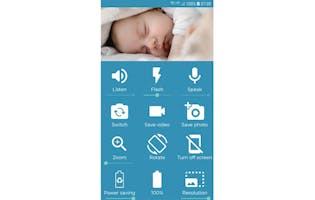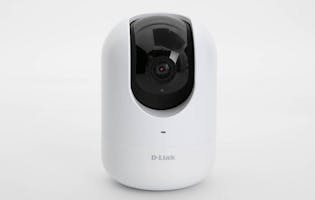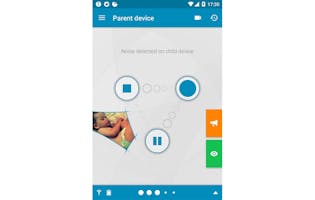Baby monitors buying guide
Can a cheap app do the job of a traditional monitor?
A baby monitor can provide peace of mind if you live in a large house or if your baby’s room is some distance from yours. We've tested audio, video and motion monitors and looked at privacy issues.
Types of baby monitors
An audio-only baby monitor may be all you need, but you may want to consider a video monitor. This allows you to check on your baby without accidentally waking them.
Monitors using common radio frequencies may pick up signals and interference from other nearby devices (including your neighbours') such as cordless phones, microwaves, or other baby monitors. Some monitors let you choose from several frequencies to minimise this. Monitors that use DECT (digital enhanced cordless telecommunication) are more private and offer less interference as the frequency isn't as common as other devices in the home.
Audio
The simplest baby monitors have a transmitter (baby unit) that's placed near the baby and a receiver (parent unit) that you keep nearby. You plug them in, make sure both units are set to the same channel, switch them on, and adjust the volume on the parent unit to a level you can easily hear.
Audio-video
Combined audio-video monitors allow you to hear and see your baby. You have a few options here: an “off-the-shelf” audio-video monitor with both a parent and baby unit, a WiFi-enabled camera and audio unit that can be monitored via your smartphone, tablet or computer or you can “make your own” by using a baby monitor app with 2 smartphones or tablets.
Baby monitor apps
You can turn 2 smartphones or tablets (or 1 of each), into a baby monitoring system by downloading a suitable app to both devices. The apps we tested performed well and are usually inexpensive, so we think they’re worth a try if you have a spare smartphone or tablet lying around.
The “child” unit uses the device's built-in microphone and camera to check baby's sound and movements, while the “parent” unit lets you keep an eye and ear on them wherever you are. One downside is picture quality, which in dark lighting can be very poor. Like all internet-enabled devices, it won't work if your connection goes down, unless both devices are 3G-enabled.
WiFi-enabled baby monitors can be viewed anywhere with an internet connection, as long as both units are in WiFi range. If you're going to view your monitor over the internet, make sure the connection is secure and the firmware is up-to-date.
Features to consider
If you're thinking about buying a baby monitor, here are some features to look for.
-
Battery operation on the parent unit means you can carry it with you around the house. A battery on the baby unit is also useful where there's no mains power (for example, if you go camping).
-
Automatic battery back-up is useful in areas where power cuts are common.
-
Low-battery indicator warns you when the battery is low.
-
Sound indicator lights allow you to "see" your child's cries on the parent unit. It's good for when you have visitors or are watching TV: simply turn down the volume and ensure you can easily see the display.
-
Belt clip lets you carry the parent unit around the house and outside.
- A room-temperature monitor displays the temperature in the child’s room. One with an alarm warns you when the temperature goes outside a set range.
- Video monitoring allows you to see as well as hear your child. A standard audio-video monitor comes with a small camera you position to view your baby by day or night (using infrared lighting). The monitor is linked to a mini-screen on the parent unit. Other video monitoring options include using a WiFi-enabled camera and audio unit and monitoring it via your smartphone, tablet or computer or downloading a baby monitor app for use with 2 devices.
- “Talk to baby” works like an intercom: it lets you murmur reassuring words to a fretful baby or issue stern instructions to a wilful toddler.
- A movement sensor is a pad under the baby’s mattress. It sounds an alarm if there’s no movement for more than 20 seconds. While these offer peace of mind, there is no evidence that using a movement sensor monitor prevents SIDS.
- A lullaby can be played if your baby stirs (although this may irritate rather than soothe).
- A night light on the baby unit gives a soft glow which may comfort the child and helps you see better in a darkened room.
Privacy and security issues
Baby monitors operating on public transmission frequencies mean anyone with a receiver (such as a two-way radio, walkie-talkie, or another baby monitor) could listen in to conversations you have near the baby monitor. If you're using a WiFi-enabled baby monitor, set it up with a secure login password known only to you (separate to your local WiFi password). If you don't change your camera's login password from the default (which is often blank), you risk leaving your connection vulnerable to hackers.
There've been several reported cases of hackers yelling at babies via unsecured WiFi baby monitors, or accessing open webcam feeds that haven't been protected with a unique password. Make sure your WiFi monitor is upgraded to the manufacturer's latest firmware version to close potential security loopholes (the instructions should tell you how to do this), and that any associated smartphone apps are also up-to-date.
We've tested 22 baby monitors.
Find the right one for you.
Arjona Software

D-Link

Dormi
